| Day 1 Beijing, Guiyang ( ) |
| Our tour guide will hold a welcome sign to meet you at the Guiyang Airport according to your flight schedule. Transfer to the hotel. Free time of explore Guiyang. |
| Jiaxiu pavilion | Jiaxiu Pavilion was initially built by a provincial governor in the 25th Year (1597) of Wanli's Reign in the Ming Dynasty , with the purpose of encouraging scholars to make progress. |
|
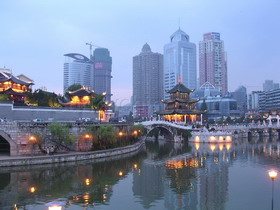 |
| [ Optional ] Jiaxiu pavilion: Jiaxiu Pavilion was initially built by a provincial governor in the 25th Year (1597) of Wanli's Reign in the Ming Dynasty , with the purpose of encouraging scholars to make progress. |
|
| Day 2 Guiyang ( B,L ) |
| Today we will drive 3.5 hours (220 KM) from Guiyang to Anshun City. Visit the Huangguoshu Waterfall. In the afternoon, Visit Tunpu Village, enjoy the Ground Opera, which is a kind of performance in which martial arts applied a lot, and a variety of coloful masks are worn by the actors. Stay overnight in Guiyang. |
| Ground Opera | Ground Opera can be traced back to the 14th century during the Ming Dynasty (1368-1644), when the armed forces of North China entered Guizhou. Originally it is a sacrificial ceremony performed by the soldiers in Tunpu area of Anshun, Guizhou, to entertain the gods and ask for victory in battle. | | Tianlong Tunpu | Tianlong Tunpu, 72 kilometers west of Guiyang, is a small village near Huangguoshu Waterfall. Since the Yuan dynasty (1271-1368), Tianlong had been an important military fortress, guarding a major gateway to the southwestern Chinese province of Yunnan. | | Huangguoshu Waterfall | The Huangguoshu Waterfall, the largest waterfall in Asia, is about 74 meters high and 81 meters wide. Hidden behind the waterfall is a 134-meter long Water-Curtain Cave with fantastic stalactites. |
|
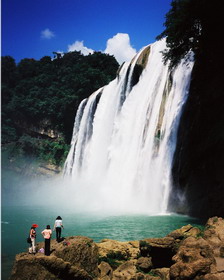 |
| [ Optional ] Huangguoshu Waterfall: The Huangguoshu Waterfall, the largest waterfall in Asia, is about 74 meters high and 81 meters wide. Hidden behind the waterfall is a 134-meter long Water-Curtain Cave with fantastic stalactites. |
|
| Day 3 Kaili ( B,L ) |
| In the morning, drive 4 hours to Kaili (350 KM). In the afternoon, we will visit Qingman Ethnic Minority village, a quiet village inhabited by the Folded & Silkfelt Miao, where we will learn about their culture. Then pay a visit to a traditional paper making in Shiqiao Village, one ancient hand-made paper. Later transferred back to Kaili. The distance we drive in the afternoon is about 110 KM, 3 hours driving for the round trip. |
| Qingman Miao Ethnic Village | Qingman is a village famous for their traditional costumes. Clothes are made by women through spinning, weaving, cross-stitching, brocading, wax printing, and sewing. Their hairs are piled high with huge quantities of red wool in an enormous bouffant style. | | Ancient Hand-made Paper in Shiqiao Village | The tradition of hand-made paper is still kept in Shiqiao. Shiqiao Village of Danzhai County is one of the villages where villagers continue to earn their living by producing and selling hand-made papers and products. |
|
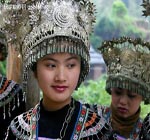 |
| [ Optional ] Qingman Miao Ethnic Village: Qingman is a village famous for their traditional costumes. Clothes are made by women through spinning, weaving, cross-stitching, brocading, wax printing, and sewing. Their hairs are piled high with huge quantities of red wool in an enormous bouffant style. |
|
| Day 4 Kaili, Rongjiang ( B,L ) |
| Today you'll be transferred to Rongjiang Country. Visit minority villages on the way, they are Paika village, is known about Lusheng, we could know how to make the Lusheng there and Datang Miao Ethnic Village. Enjoy the nice natural view of Leigongshan Mountain and Shui Ethnic Village. The road is mountain road, total journey is 180 KM, 4 hours driving. Arrive Rongjiang in the late afternoon. If we still have time, we will visit Chejiang Dong ethnic village nearby. |
| Leigong Mountain | Leigong Mountain ("God of Thunder" Mountain) and its surrounding areas, roughly defined by modern-day Leishan County in the southeast of Guizhou province, are the ancestral home of the Miao minority group. | | Paika village | The PaiKa village is known for its manufacture of Lushengs, the characteristic musical instrument of the Miao. Visit the home of a Lusheng maker and know more about Lusheng-the Miao people's most important musical instrument. | | Datang and Xinqiao Miao village | Datang and Xinqiao Miao village are well known for their traditional dance performances, with an aquatic granary as well as the Miao version of the miniskirt. | | Chejiang Dong Village | Dong village in CheJiang is famous lots of acitivities under dozens of Banyan trees. People are busy pounding the life out of some black (indigo-dyed) cloth with a heavy, wooden mallet. The pounding softens the cloth and then it into a shiny blue-black color. It takes hours and days of pounding to …… |
|
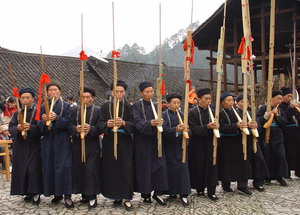 |
| [ Optional ] Paika village: The PaiKa village is known for its manufacture of Lushengs, the characteristic musical instrument of the Miao. Visit the home of a Lusheng maker and know more about Lusheng-the Miao people's most important musical instrument. |
|
| Day 5 Zhaoxing ( B,L ) |
| Today you will be transferred to Zhaoxing village for about 4 hours driving (160 KM). Visit Basha Miao Ethnic village on the way. Today is the highlight for the whole southeastern Guizhou trip. Basha and Zhaoxing are the best reserved villages in this area. |
| Zhaoxing Dong Village | Zhaoxing, one of the largest Dong villages in the region, with more than 700 households and a population of 4000. The Dong people in Zhaoxing are all surnamed Lu. According to an old man, the head of the Dong people in Zhaoxing divided the people into five groups in order to make administration easi…… | | Flower Bridges in Zhaoxing | There are five bridges in Zhaoxing. Actually, the bridge is more of a building across the river, as most bridges are covered with pavilions. The bridges have earned the name "flower bridges" because of the exquisite sculptures that cover them. On a raining day, to sit in the bridge pavilion and chat…… | | Basha Miao Ethnic Village | Basha (Biasha) Miao Ethnic village is a very special and old Miao Ethnic village. The villagers remain their unique tradition since Qing Dynasty( about 2200 years ago). All the men comb their hair with a very special hair, caring a knife on the waist and a traditional fowling piece, dressing like an…… | | Drum Towers in Zhaoxing | The most famous buildings in Zhaoxing are the five drum towers. According to the tradition of the Dong people, each individual drum tower represents one group of local people. The five towers represent kindness, righteousness, politeness, intellect and creditworthiness. |
|
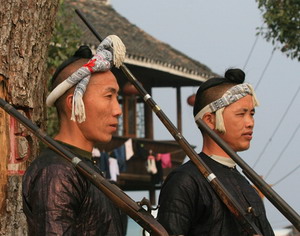 |
| [ Optional ] Basha Miao Ethnic Village: Basha (Biasha) Miao Ethnic village is a very special and old Miao Ethnic village. The villagers remain their unique tradition since Qing Dynasty( about 2200 years ago). All the men comb their hair with a very special hair, caring a knife on the waist and a traditional fowling piece, dressing like an accient Chinese warrior. The people rarely venture out of the village except for selling firewood and shopping for daily necessities in markets, and both men and women can be seen in traditional cost |
|